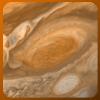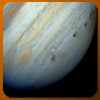You are seeing this message because you are using an out-of-date browser.
Please click here for more information.
King of the Planets
The fifth planet in our solar system is also the largest planet in our system, both in size and mass. Jupiter's diameter of over 85,000 miles is almost twelve times that of Earth and its mass is well over twice as much as all the rest of the planets put together. These facts make it appropriate that the planet is named after the king of all the other gods in ancient Roman mythology.
Jupiter is also the first of the gas planets in our system. A gas planet is one that does not have a solid surface like Earth. Instead, you can think of Jupiter, as well as the rest of the gas planets, as being a giant ball of mostly hydrogen and helium. Scientists believe that Jupiter has a small rocky core at its center, but even the core of this giant planet is much larger than our Earth.
Jupiter's size not only makes it the largest planet in our solar system, it has also helped us explore the outer planets. Scientists have used the planet's gravity to accelerate spacecraft and send them one their way to Saturn, Uranus and Neptune.
Ruler of the Night Skies
Jupiter's extremely large size has made it a favorite observation subject for professional and amateur astronomers ever since Galileo used his first primitive telescope almost four hundred years ago. Using even a small telescope, you are able to see the distinctive color bands of Jupiter's atmosphere as well as the four large Galilean moons. Using a medium-sized telescope, you should be able to see the Great Red spot just south of Jupiter's equator. In fact, you can see the four Galilean moons of Jupiter using just a good pair of binoculars.
You can check the Sky Maps section here at Astronomy for Kids. If Jupiter is visible during the current month, we will tell you where and when to see it.
A Miniature Solar System
Considering that Jupiter is by far the largest planet in our solar system, it is only fitting that it also has the largest number of moons. The four large Galilean moons, along with at least fifty-seven smaller moons, some of which haven't even been named yet, make up what looks like a small scale solar system.
The four Galilean moons are both easy to see with a small telescope and are fascinating subjects in their own right. Ganymede, the largest of Jupiter's moons, is larger than the planets Pluto and Mercury. Europa apparently has an ocean under its icy surface and tiny Io has many active volcanoes. You can find out more about the interesting moons of Jupiter by clicking on the link at right.
The Great Red Spot
Jupiter's Great Red Spot is one feature of our solar system that almost everyone is at least somewhat familiar with. This red spot is actually a huge storm that has been raging on Jupiter for at least 400 years.
Although the Great Red Spot is the most famous feature of Jupiter, it is just one part of the complex atmosphere of the giant planet. The distinctive color bands that we see in pictures of Jupiter are a result of very high winds, the makeup of the planet's atmosphere and the planet's high rotation speed. A "day" on Jupiter is just a little over ten hours long, which means that not only is Jupiter huge, but it rotates very fast on its axis. Click on the link at right to learn more about the planet's fascinating atmosphere.
Comet Shoemaker-Levy 9 Hits Jupiter!
In July of 1994, something occurred in our solar system that only happens at most once every several thousand years. Over a period of about a week, pieces of comet Shoemaker-Levy 9 crashed into Jupiter. This was the first time in history that we were able to see and closely study such a spectacular event. Telescopes around the world, as well as the Hubble Space Telescope watched in awe as fragment after fragment of the comet hit the planet, leaving scars in the clouds that remained visible for over a year. It was a very exciting time. Click on the link at right to learn more about this extremely rare event.
Jupiter's Rings
As the Voyager spacecrafts traveled through our solar system, they sent back many pictures things we expected to see, and even more images that were a complete surprise. One of the many new facts we learned from these missions was that Jupiter has rings. Of course we had known that Saturn had rings for several hundred years, but the discovery of rings around Jupiter was completely unexpected. It turned out that all of the gas planets have rings, but we didn't even suspect this until Voyager sent back the pictures. You can learn more about the very faint rings around Jupiter by clicking on the link at right.
Solve the Puzzle!
Find Out More About Jupiter
- Jupiter Page at the Nine Planets Site
- The Jupiter section of the Nine Planets site has more detail about the giant planet.
- The Voyager Missions
- Visit the Voyager mission web site to learn more about the spacecraft that gave us our first real tour of the outer solar system.
- The Galileo Mission
- The Galileo spacecraft arrived at Jupiter in December of 1995 and continues to send back exciting information and pictures.
- Galileo
- Find out more about the man who gave us our first looks into many of our planetary neighbors.
Get the Acrobat file for this topic
There is an Adobe® Acrobat® file (116k) for Jupiter. You can view the file online by clicking
here. You can save the file on your computer by right-clicking on the link.
You will need the free
Adobe® Acrobat® ReaderTM
to view the file.
This entire site copyright © 2003 Astronomy for Kids - all rights reserved






